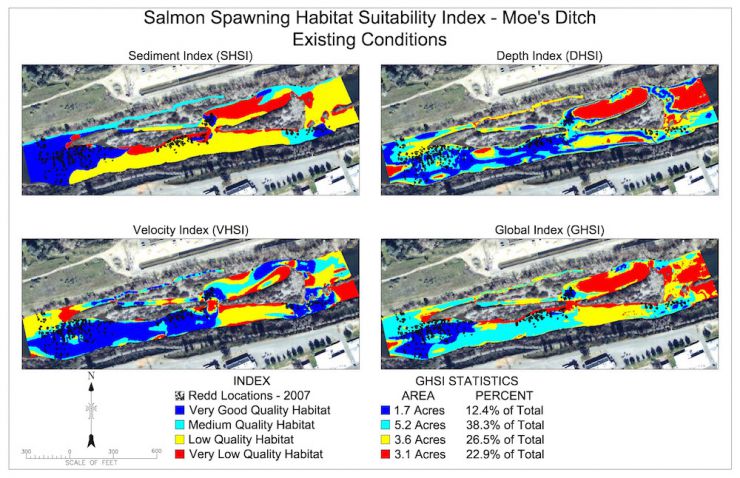Feather River
Overview
The Feather River is home to the major water source for the California State Water Project above Oroville Dam as well as major hydropower facilities. As with other regulated rivers draining the Central Valley of California, its upper watershed is cut off to fish passage by the height of Oroville Dam and its immense reservoir. The river below is highly degraded and in need of comprehensive rehabilitation.
2006-2009 Auditorium Riffle SHR Design Development
Auditorium Riffle is the upstream-most gravel bar and riffle geomorphic unit complex on the Feather River below Oroville Dam. In October 2006 Prof. Pasternack was invited to collaborate with the California Department of Water Resources and MWH America's Inc on assessing opportunities for rehabilitating Auditorium Riffle. He training DWR staff in the use of SHIRA. He also work on the pre-project characterization and design development phases of an HR project at the site. The model prediction maps shown below illustrate how actual past redd observations compared to different habitat conditions as well as the combined (aka global) habitat suitability condition.

A conference proceeding (see below) was written to transparently document what was done. Unfortunately, because the FERC relicensing for Oroville has been held up for so long, this project was not implemented timely.
Eventually, a project was done at the site in June 2014, as reported in the Chico Enterprise-Record. Eric See reported that the number of salmon redds more than doubled as a result of this project.
2010-2012 Habitat Expansion Plan Development
DWR, PG&E, and multiple stakeholders entered into an agreement called the Habitat Expansion Agreement (HEA). The HEA directed the project licensees to develop a Habitat Expansion Plan (HEP) elsewhere in the Sacramento River Basin in lieu of a NMFS Section 18 Fish Passage Prescription for the four “Feather River Projects” (DWR/P-2100 & PG&Es Poe/P-2107, Rock-Creek Cresta/P-1962, and Upper NF Feather/P-2105). An open and transparent process was used to seek ideas from anyone interested as to what might constitute the HEP. By 2010 it was apparent that the best opportunity for meeting HEA goals would involve taking action on the lower Yuba River. As Prof. Pasternack was already heavily involved in geomorphic and ecological assessments and river rehabilitation on the lower Yuba River, he was sought out to advise on the HEP. From spring 2010 to summer 2012 Prof. Pasternack collaborated with DWR, PG&E, and ICF International on the assessment of potential river rehabilitation activities and subsequent development of a planning-level strategy. Prof. Pasternack envisioned the river rehabilitation actions and estimated what the salmonid benefits would be using the best-available methods suitable at the planning level. These results are presented in the documents below. Had the project moved forward as envisioned, it would have served many thousands of Chinook salmon spawners- certainly as many as required by the HEA. However, NMFS blocked the HEP from moving forward.
2017 Oroville Spillway Disaster
In winter 2017 Oroville Dam's concrete spillway failed fr several reasons, including years of undermining and lifting by flood releases, causing massive damage to the hillside and downstream channel. Over the months that followed, controlled and uncontrolled flooding caused extensive erosion of the hillside upstream of Auditorium Riffle as well as channel and bank erosion downstream along the Feather River. Sediment must have deposited downstream somewhere as well. However, it is unknown what scientific investigations are being done to assess the consequences of these events.
The Oroville Mercury-Register reported that as of summer 2017 SHR gravel placement remains held up by the delay in Oroville Dam relicensing, but 5,000 cubic yards of gravel were placed into the river at three sites that summer.
Documents
- Manwaring, M., Cepello, S., Kennedy, S., Pasternack, G.B. 2009. Spawning riffle gravel supplementation for anadromous spring-run Chinook salmon and steelhead. Waterpower XVI, July 27-30, Spokane, WA. p. 1-18.
- Pasternack, G. B. 2010. Estimate of the number of spring-run Chinook salmon that could be supported by spawning habitat rehabilitation at Sinoro Bar on the lower Yuba River. Prepared for the Habitat Expansion Agreement Steering Committee, California Department of Water Resources and Pacific Gas & Electric Company.
- Pasternack, G. B. 2010. Estimate of the number of spring-run Chinook salmon supportable by spawning habitat rehabilitation in the Narrows Reach of the lower Yuba River. Prepared for the Habitat Expansion Agreement Steering Committee, California Department of Water Resources and Pacific Gas & Electric Company.
- Habitat Expansion Plan
